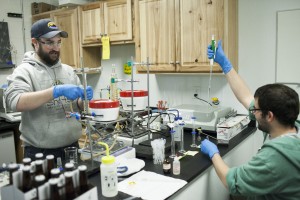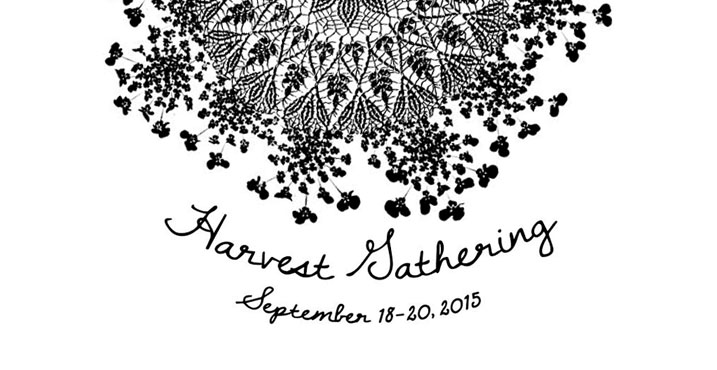Yeast are fascinating little buggers. They are nothing more than single-celled fungi, yet they have quite a number of tricks up their sleeves: raising bread, producing alcohol, and changing the flavor in beer are three of their most popular. Since yeast plays a large part in beer production, we decided to talk to our beer scientist, Tyler Glaze, and share his yeasty insight with you. Enjoy!
1. Okay Tyler, let’s start with the basics. What are yeast?
Yeast are eukaryotic microorganisms. Single celled microorganisms were actually the first forms of life to develop on earth. Yeast are like fancier, fully-equipped versions of those little fellas.
2. How many yeast strains are out there in the world? What ones do we commonly use?
Heaps! I don’t think anyone really knows how many different strains of yeast there are on the planet. As far as the yeasts that we use, Saccharomyces cerevisiae strains are used in our ales and Saccharomyces pastorianus strains are used in all of our lagers. We use some Brettanomyces (commonly referred to as “Brett”) in some of our experimental pub brews in Bellaire. Most of the time, brewers are working hard to keep this yeast away from their beer because it creates a lot of off-flavors in traditional styles. However, from time to time brewers welcome it in their beer to produce a fruity, spicy, earthy, or “funky” flavor. Funky flavors include phenolic (old-timey-band-aid), goat, horse blanket, and gym socks. These flavors are desirable in some styles and commonly created by Brett. This year we brewed Golden Eagle with the Brettanomyces yeast.
3. Brewing is an experimental process. What are some common unwelcome by-products of yeast that brewers need to watch out for?
1. Diacetyl – It tastes like butter and is made naturally by yeast and spoiling bacteria. Yuck.
2. Dimethyl sulfide – This smells like canned corn and is caused by wimpy boils in the kettle or prolonged whirlpooling. This also smells pretty gross.
3. Hydrogen sulfide – This smells like rotten eggs and is caused by poor quality brewing water, spoilage bacteria, and suicidal yeast. Le pew.
4. Acetaldehyde – This smells like nail polish and indicative of yeast stress and/or an incomplete fermentation. Sometimes this is welcome in certain beer styles.
5. Lactic acid – It tastes like sweet tarts and is caused by spoilage bacteria and some Brett species. Yick, yick, yick!
4. Since there are so many yeast strains found on planet earth, what do you recommend homebrewers purchase? Is just plain old bread yeast not acceptable?
I would suggest that homebrewers should pick up a vial, smack pack, or pouch of brewers yeast from their local homebrew shop or online retailer. White Labs, Wyeast, and Fermentis are pretty big suppliers. A lot of times a local microbrewery will give you some of their yeast to use for your fermentation. Ask around, but ask nicely. Sometimes they will be able to give you a little bit of yeast if you bring in a small container. I wouldn’t count on it, but I’ve seen it happen before.
Most bread yeasts aren’t going to produce a good tasting beer. Brewer’s yeasts have been specifically bred to make good beer. Bread yeasts have been bred to make bread. I love puns.
 5. I should have asked this earlier, but how in the world does yeast produce alcohol and carbon dioxide?
5. I should have asked this earlier, but how in the world does yeast produce alcohol and carbon dioxide?
The metabolism of yeast is quite complex and this explanation will not fully explain everything that goes on, but it should give you an idea.
The sugars in wort are transported across the cell wall of the yeast cell using transport proteins. Yeast don’t like to think that all sugars are created equally, so they like to eat them in a weird order. Kind of like how most people eat the pink and red Starbursts first and leave the yellow and orange ones for later. Anyways, sucrose, a 12-carbon sugar, must first split into glucose and fructose, each a 6-carbon sugars. This happens outside of the yeast cell with an extracellular enzyme. Then glucose, fructose, maltose, and maltotriose are transported across the cell membrane, in that order. After that, maltose is broken down into two glucose molecules. That’s when the party begins. Glucose and fructose are now destined to travel down the Embden Meyerhof Parnas (EMP) pathway. The EMP pathway splits the 6-carbon sugars, glucose and fructose, down into two 3-carbon pyruvate molecules via a sequence of 10 enzymes and 10 intermediary compounds.
…Blah blah blah! Now for the fun part!
Pyruvate is then karate chopped lengthwise by the enzyme pyruvate dehydrogenase, cleaving off a CO2 and creating acetaldehyde. Acetaldehyde is then double-face-punched by both NADH and alcohol dehydrogenase at the same time blasting its molecular mouth oxygen with a hydrogen molecule and creating ethanol. Sweet, sweet ethanol.
6. Wow! That sounded very sciency. So if I saw one of these very talented microorganisms walking down the street, how would they look?
They look like they want to party. They are so good at partying that they don’t even BYOB, they make it! Give them a little O2 before they walk in the door, then cut off their air supply, dump sugar on them and let them get to work!
 7. I know there is a whole lot more that we could talk about, but do you recommend any books or resources for homebrews to learn more about yeast and its effects on beer?
7. I know there is a whole lot more that we could talk about, but do you recommend any books or resources for homebrews to learn more about yeast and its effects on beer?
There are some great resources available if you are interested in learning more about yeast and how it affects beer. The book Yeast: The Practical Guide to Yeast Fermentation by Jamil Zainasheff is a good one. There is also e-book by John Palmer called howtobrew.com that has a ton of information.
8. Any last words you want to share about yeast and brewing?
Why yes I do, Pauline. I want to tell people not to be afraid of experimentation. If you don’t try brewing with different yeast strains, then you will never know what magic or obscene evil you might create! It takes a lot of trial and error, but that is what makes a good brewer a great brewer.
 Tyler studied at California Polytechnic State University, San Luis Obispo as a Microbiology/Biochemistry Undergraduate student and escaped before graduation to explore the United States and try all of its beer. By sheer luck, Tyler landed in a seat at the Bellaire Pub and was hired shortly after for a summer internship. Soon, he found himself managing the Quality Department at Short’s and, while working at Short’s, attended the prestigious University of California, Davis Extension, Master Brewer’s Program where he learned the science and engineering behind the beer we all love. Shortly after, Tyler received his Diploma in Brewing from the Institute of Brewing and Distilling, London, U.K. Tyler lives in Elk Rapids with a large fridge full of Huma Lupa Licious.
Tyler studied at California Polytechnic State University, San Luis Obispo as a Microbiology/Biochemistry Undergraduate student and escaped before graduation to explore the United States and try all of its beer. By sheer luck, Tyler landed in a seat at the Bellaire Pub and was hired shortly after for a summer internship. Soon, he found himself managing the Quality Department at Short’s and, while working at Short’s, attended the prestigious University of California, Davis Extension, Master Brewer’s Program where he learned the science and engineering behind the beer we all love. Shortly after, Tyler received his Diploma in Brewing from the Institute of Brewing and Distilling, London, U.K. Tyler lives in Elk Rapids with a large fridge full of Huma Lupa Licious.



